The Algorithm
Briefly...
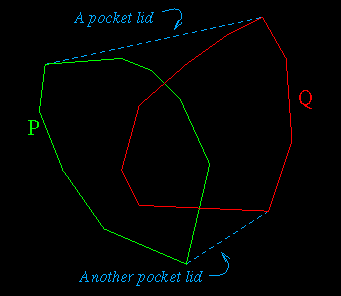 Let P and Q be two convex polygons whose intersection is
a convex polygon.The algorithm for finding this convex intersection
polygon can be described by these three steps:
Let P and Q be two convex polygons whose intersection is
a convex polygon.The algorithm for finding this convex intersection
polygon can be described by these three steps:
-
Construct the convex hull of the union of P and Q;
-
For each pocket lid of the convex hull, find the intersection of P
and Q that lies in the pocket;
-
Merge together the polygonal chains between the intersection points found
in 2.
What's a pocket lid?
A pocket lid is a line segment belonging to the convex hull of the
union of P and Q, but which belongs to neither P nor
Q.
Why does it connect a vertex of P with a vertex of Q?
A pocket lid connects a vertex of P with
a vertex of Q; if it were to connect two vertices of P, then
P would not be convex, since the lid lies on the convex hull and
is not a segment of P.
In detail...
Computing the Convex Hull: the Rotating Calipers
To compute the convex hull of the two convex polygons,
the algorithm uses the rotating calipers. It works as follows:
-
Find the leftmost vertex of each polygon.
-
At each of those two vertices, place a vertical line passing through it.
Associate that line to the polygon to which the vertex belongs. The line
does not intersect its associated polygon, since the polygon is convex
. See the figure below:
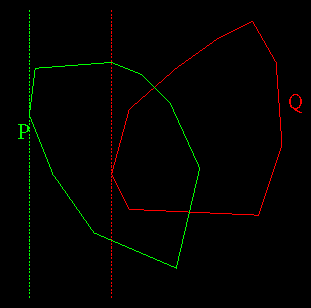
-
Rotate these two lines (called calipers) by the smallest angle between
a caliper and the segment following the vertex it passes through (in clockwise
order). The rotation is done about the vertex through which the line passes
on the associated polygon. If the line passes through more than one vertex
of the assciated polygon, the farthest (in clockwise order) is taken. The
result is show below:
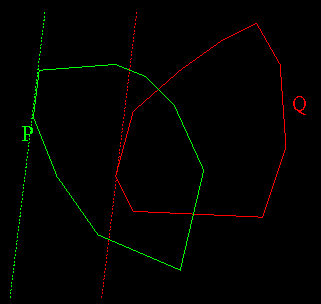
-
Whenever the order of the two calipers change, a pocket has been
found. To detect this, a direction is associated to one of the lines (for
example the green one, associated to P). Then all points of the
red line (associated to Q) are either to the left or to the right
of the green line. When a rotation makes them change from one side to the
other of the green line, then the order of the two lines has changed.
Here's what our example looks like just before and after the algorithm
has found the first pocket; as you can see, if the line associated with
P initially had its associated direction pointing up, then the line
associated with Q was to the right of it at the beginning, and is
now to the left of it:
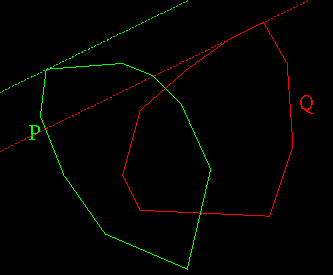
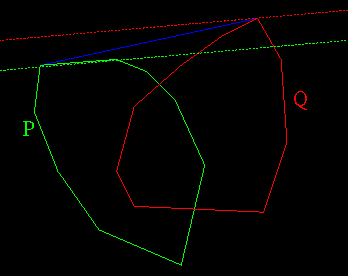
-
The algorithm terminates once it has gone around both polygons.
Finding the intersection of P and Q in the pocket
Once the pockets have been found, the intersection
of the polygons at the bottom of the pocket needs to be determined. The
pockets themselves form a very special type of polygon: a sail polygon:
that is, a polygon composed of two concave chains sharing a common vertex
at one extermity, and connected by a segment (the mast) at the other
end. By a procedure similar to a special-purpose triangulation for sail
polygons, the segments of P and Q which intersect can be
identified in O(k+l), where k and l are the
number of vertices of P and Q which are inside the pocket.
The idea is to start the triangulation from the mast, and as points from
P and Q are considered, a check is made to see that the chain
from Q is still on the same side as the chain from P.
Here is a pseudo-code of this algorithm. It is assumed
that the indices of the vertices of P and Q are in increasing
order from the lid to the bottom of the pocket (i.e.: P and Q
are not enumerated in the same order).
Procedure FindBottom
i <- 1; j <- 1;
repeat
finished <- true;
while ( leftTurn(
p(i), p(i+1), q(j+1) ) ) do
begin
j <- j + 1;
finished <- false;
end
while ( rightTurn(
q(j), q(j+1), p(i+1) ) ) do
begin
i <- i + 1;
finished <- false;
end
until finished
At the end of this procedure, the indices i and j
indicate the vertices of P and Q, respectively, which are
at the start of the two intersecting segments (in other words, the two
intersecting segments are p(i),p(i+1) and
q(i),q(i+1). The intersection of these two segments is part of
the intersection polygon, and can be found with your favorite line intersection
formula.
Merging
What remains to be done is to build the resulting
polygon. One way of doing this is to start at one of the vertices given
by the above algorithm, compute the intersection, add that
point, and then to continue adding points by following either P
or Q deeper below the pocket until it comes out of another pocket
(i.e. until the vertex to consider for addition happens to have been the
output of the algorithm for another pocket). Then from that pocket the
chain of the other polygon can be followed under the pocket. This would
be done until the pocket the chain comes out of is the pocket that
the merging started with.
Checking for intersection
All of this assumes that the polygons do intersect.
However, there are three ways in which no polygonal intersection could
exist:
-
The intersection is either a point or a line. No provisions are made for
this in the algorithm, and in this case the output will be a polygon consisting
of either two vertices at the same location(in the case of a point), or
four vertices on two distinct locations (in the case of a line);
-
The polygons simply do not intersect each other and are seperable;
-
The polygons are one inside another. One could argue that the intersection
of two such polygons is the contained polygon, but that is the computer
graphics way of seeing things. In mathematics, there is no intersection
in such a case. In any event, the algorithm has to detect this case independently
of wether or not it outputs it as an intersection or not.
For case 2, this is detected if, during the triangulation step, the algorithm
makes a complete loop around one of the polygons. Detecting case 3 is even
easier to detect ; in such a case no pockets will be found by the convex
hull algorithm.
Implementation notes
As implemented in the applet, the algorithm will only
find intersections which form non-degenerate polygons. In other words,
it will not handle properly intersections which consist of a single line
or point. However, the algorithm does detect the cases where no intersection
exists at all: in the case where one polygon is contained in another, the
rotating calipers will not find any pockets; in the case where the two
polygons are completely outside one another, the triangulation algorithm
will detect that it has looped around one of the polygons.
Also, the assumption of generality of the point
positions also holds in the implementation. If the points are not in general
position, the intersection might be a degenerate polygon, or the
intersection polygon might contain two consecutive segments which lie on
the same line.
In the article, one polygon is enumerated in clockwise
order, the other in counter-clockwise order. The implementation has both
polygons in clockwise order; it simply involves a bit more housekeeping
and a bit of extra care in the merging step.
Forcing input of a convex polygon
The interface for building the polygons has the nice
feature (or annoying feature, depending on your character), of forcing
the user to enter a convex polygon in clockwise order. This is done with
a simple online algorithm that checks the following conditions while inserting
a new vertex i+1 between vertex i and vertex i+2:
-
vertices i-1, i, i+1 form a right turn;
-
vertices i, i+1, i+2 form a right turn;
-
vertices i+1, i+2, i+3 form a right turn.
In the code, this is actually implemented as a point being to the left
(over) or to the right (under) of a line, rather than left turns and right
turns, but the idea is exactly the same.
Follow the links below:




 Let P and Q be two convex polygons whose intersection is
a convex polygon.The algorithm for finding this convex intersection
polygon can be described by these three steps:
Let P and Q be two convex polygons whose intersection is
a convex polygon.The algorithm for finding this convex intersection
polygon can be described by these three steps:



